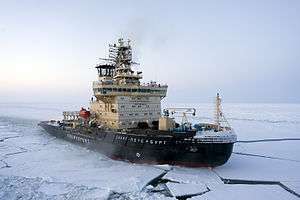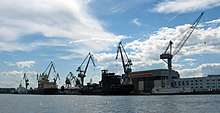Sankt-Peterburg (icebreaker)
Sankt-Peterburg (Russian: Санкт-Петербург; literally: Saint Petersburg) is a Russian diesel-electric icebreaker. She was built at Baltic Shipyard in 2009 as the second vessel for Project 21900, the first series of non-nuclear icebreakers built in Russia after the dissolution of the Soviet Union. She has an identical sister ship, the 2008-built Moskva.
 Sankt-Peterburg, the second icebreaker of the series, in Kara Sea in 2015 | |
| History | |
|---|---|
| Name: | Sankt-Peterburg (Санкт-Петербург) |
| Namesake: | Saint Petersburg |
| Owner: | Rosmorport[1] |
| Port of registry: | Saint Petersburg[2] |
| Ordered: | May 2005[3] |
| Builder: | Baltic Shipyard (Saint Petersburg, Russia) |
| Cost: | $75 million[4] |
| Yard number: | 05602[2] |
| Laid down: | 19 January 2006[5] |
| Launched: | 28 May 2008[6] |
| Completed: | 12 July 2009[7] |
| Identification: |
|
| Status: | In service |
| General characteristics [2] | |
| Class and type: | Project 21900 icebreaker |
| Tonnage: | |
| Displacement: | 14,300 t (14,100 long tons) |
| Length: | 114 m (374 ft) |
| Beam: | 27.5 m (90 ft) |
| Draught: | 8.5 m (28 ft) |
| Depth: | 12.40 m (41 ft) |
| Ice class: | RMRS Icebreaker6 |
| Installed power: | |
| Propulsion: | Diesel-electric; two Steerprop SPO 4.5 ARC azimuth thrusters (2 × 8,200 kW) |
| Speed: |
|
| Crew: | 25[8] |
| Aviation facilities: | Helideck for Ka-32 and Ka-226[6] |
Following the construction of Sankt-Peterburg, three icebreakers of slightly upgraded design (Vladivostok, Murmansk and Novorossiysk) were built in 2015–2016.
Development and construction

In July 2004, the Saint Petersburg-based Baltic Shipyard won an international tender for the construction of two 16-megawatt diesel-electric icebreakers for Rosmorport, a state-owned company established in 2003 to manage Russia's port infrastructure and operate its fleet of diesel-powered icebreakers.[4] Although the shipyard had built five Arktika-class nuclear-powered icebreakers in 1975–1992 and had the sixth under construction at the time, these would be the first non-nuclear icebreakers built on a Russian shipyard in over three decades and the first new icebreakers ordered following the dissolution of the Soviet Union.[9]
The contract for the construction of the second Project 21900 icebreaker was signed in May 2005 shortly after the lead ship was laid down at Baltic Shipyard.[3] Initially, she was supposed to be delivered in November 2007, one year after the first vessel of the series.[4] The keel laying ceremony was held on 19 January 2006[5] and the hull was launched on 28 May 2008. While delivery was initially scheduled for late 2008,[6] she was officially commissioned on 12 July 2009.[7]
Project 21900 icebreakers are named after major Russian cities with Sankt-Peterburg named after the country's second-largest city. While the naming of the vessels also follows that of a series of five diesel-electric polar icebreakers built by Wärtsilä in the 1960s,[10] Sankt-Peterburg's Soviet-era counterpart was naturally named Leningrad.[11]
Design
Sankt-Peterburg is 114 metres (374 ft) long overall and 103.68 metres (340 ft) between perpendiculars, and has a moulded beam of 27.5 metres (90 ft). Fully laden, the 14,300-tonne (14,100-long-ton) icebreaker draws 8.5 metres (28 ft) of water.[2] She is strengthened for icebreaking according to Russian Maritime Register of Shipping ice class Icebreaker6 which is intended for icebreaking operations in non-Arctic freezing seas where the ice is up to 1.5 metres (5 ft) thick.[12]
Sankt-Peterburg has a fully integrated diesel-electric propulsion system with main diesel generators supplying power for both main propulsion as well as ship's service loads while underway. Her main power plant consists of two 4,500-kilowatt (6,000 hp) 9-cylinder Wärtsilä 9L32 and two 6,000-kilowatt (8,000 hp) 12-cylinder Wärtsilä 12V32 medium-speed diesel engines.[2] In addition, there are two 670-kilowatt (900 hp) Wärtsilä 4L20 auxiliary diesel generators for use when the vessel is at port.[13][14]
For main propulsion, Sankt-Peterburg is fitted with two electrically driven azimuth thrusters. The 4.5-metre (15 ft) stainless steel propellers[15] of her pushing-type Steerprop SPO 4.5 ARC[16] Z-drive units are each driven by two 4,100 kW (5,500 hp) electric motors in tandem,[2] resulting in a combined propulsion power output of about 16 megawatts (21,000 hp).[8] This is enough to give Sankt-Peterburg a service speed of 16 knots (30 km/h; 18 mph) in open water[2] and allow breaking 1-metre (3.3 ft) level ice with a 10-to-20-centimetre (4 to 8 in) snow cover at a continuous speed of 3 knots (5.6 km/h; 3.5 mph) in line with her ice class.[12][15] While the azimuthing propulsion units improve the maneuverability of the icebreaker,[8] she is also fitted with a single transverse bow thruster.[13]
Career
The two Project 21900 icebreakers were originally built to ensure year-round transportation of crude oil from the terminal in Primorsk.[4] Sankt-Peterburg's primary mission was to escort oil tankers up to 50 metres (164 ft) in breadth in the Gulf of Finland. In addition, she was designed to carry out various secondary tasks such as firefighting and oil spill response operations.[8] Since 2015, Sankt-Peterburg has occasionally been stationed in the Arctic LNG terminal of Sabetta in the Gulf of Ob during the winter months.
Sankt-Peterburg has also regularly participated in the annual Festival of Icebreakers in Saint Petersburg. The icebreaker has been open to visitors in every festival since 2014 except 2015 when she was replaced by her sister ship Moskva.[17][18][19][20][21][22] In July 2012, she visited France and was open to visitors as part of the maritime festival in Brest.[23]
References
| Wikimedia Commons has media related to Sankt-Peterburg. |
- "Sankt-Peterburg (9326586)". Equasis. French Ministry for Transport. Retrieved 19 May 2019.
- "Sankt-Peterburg (060054)". Register of ships. Russian Maritime Register of Shipping. Retrieved 19 May 2019.
- ""Росморпорт" закажет Балтийскому заводу второй ледокол" (in Russian). Kommersant. 16 May 2005. Retrieved 20 May 2019.
- "Для Приморска построят ледоколы" (in Russian). dp.ru. 21 October 2004. Retrieved 20 May 2019.
- "Балтийский завод строит второй дизельный ледокол для Росморпорта" (in Russian). RIA Novosti. 19 January 2006. Retrieved 9 June 2019.
- "Балтийский завод спустил на воду ледокол "Санкт-Петербург"" (in Russian). RIA Novosti. 28 May 2008. Retrieved 9 June 2019.
- "Владимир Путин на борту ледокола" (in Russian). RIA Novosti. 13 July 2009. Retrieved 9 June 2019.
- "The Moskva to serve St. Petersburg". PortNews. 12 December 2008. Retrieved 19 May 2019.
- "RosMorPort takes delivery of diesel-electric icebreaker Moskva built by Baltiysky Zavod". PortNews. 11 December 2008. Retrieved 19 May 2019.
- Wärtsilä-yhtymä O/Y Hietalahden telakka (1960), 22000 ahv:n polaarijäänmurtajat Moskva ja Leningrad, Helsinki: Oy Weilin & Göös Ab
- "Leningrad (5206104)". Sea-web. Retrieved 9 June 2019.
- "Rules for the Classification and Construction of Sea-Going Ships, Part I: Classification". Russian Maritime Register of Shipping. 2019. Retrieved 9 June 2019.
- "Sankt-Peterburg (9326586)". Sea-web. Retrieved 19 May 2019.
- "Почти 4 млн рублей за запчасти к ледоколу «Москва» отдаст Росморпорт" (in Russian). Sudostroenie.info. 7 November 2014. Retrieved 9 June 2019.
- "STEERPROP : Build biggest ever Azimuth Propulsors". Seohyun E&C Co. Ltd. 16 April 2014. Retrieved 9 June 2019.
- "The icebreaker of Pr.21900". Marine Propulsion Systems Ltd. Retrieved 19 May 2019.
- "The first Festival was held in St. Petersburg ice breakers". PetersburgCity.com. 5 July 2014. Retrieved 12 June 2019.
- "St. Petersburg hosts 3rd Icebreakers Festival". The Arctic. 4 May 2016. Retrieved 12 June 2019.
- "Massive & impressive: Icebreaker festival kicks off in St. Petersburg (VIDEO, PHOTOS)". Russia Today. 30 April 2017. Retrieved 12 June 2019.
- "V Ice Breaker Festival". Visit Petersburg. Retrieved 12 June 2019.
- "The 6th Festival of Icebreakers Took Place In St. Petersburg". Tsarism. 15 May 2019. Retrieved 12 June 2019.
- "World's Only Festival of Icebreakers to Be Held in Saint-Petersburg on May 2 – 3". Navigator Logistic. 18 April 2015. Retrieved 12 June 2019.
- "Tonnerres de Brest. Brise-glace Saint-Petersbourg : la douche froide" (in French). Le Télégramme. 12 July 2012. Retrieved 12 June 2019.